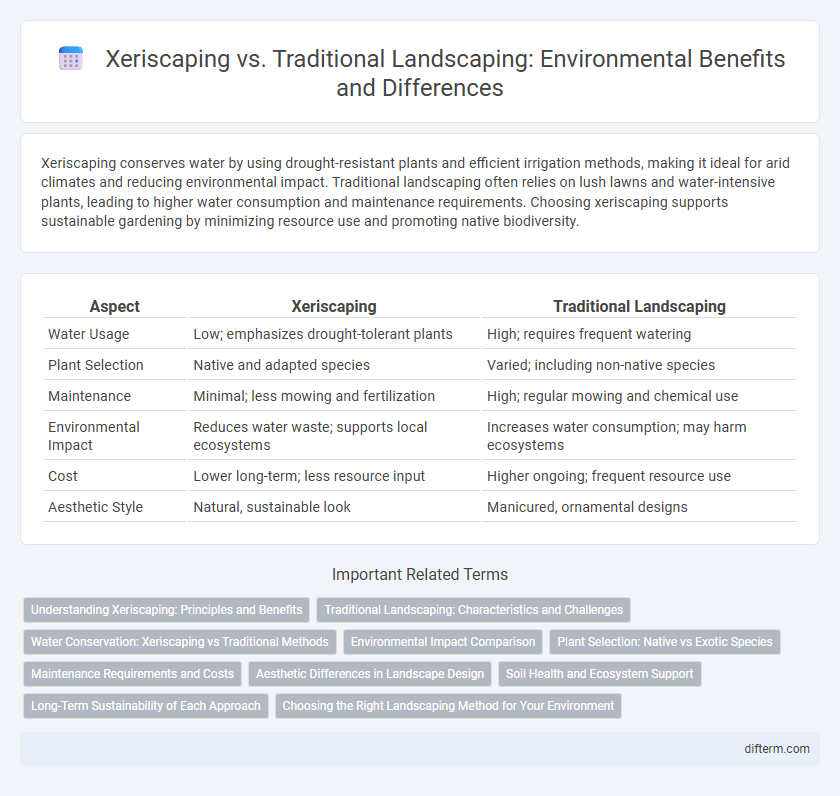Xeriscaping conserves water by using drought-resistant plants and efficient irrigation methods, making it ideal for arid climates and reducing environmental impact. Traditional landscaping often relies on lush lawns and water-intensive plants, leading to higher water consumption and maintenance requirements. Choosing xeriscaping supports sustainable gardening by minimizing resource use and promoting native biodiversity.
Table of Comparison
| Aspect | Xeriscaping | Traditional Landscaping |
|---|---|---|
| Water Usage | Low; emphasizes drought-tolerant plants | High; requires frequent watering |
| Plant Selection | Native and adapted species | Varied; including non-native species |
| Maintenance | Minimal; less mowing and fertilization | High; regular mowing and chemical use |
| Environmental Impact | Reduces water waste; supports local ecosystems | Increases water consumption; may harm ecosystems |
| Cost | Lower long-term; less resource input | Higher ongoing; frequent resource use |
| Aesthetic Style | Natural, sustainable look | Manicured, ornamental designs |
Understanding Xeriscaping: Principles and Benefits
Xeriscaping utilizes drought-resistant plants, efficient irrigation, and soil improvement to drastically reduce water consumption compared to traditional landscaping. This sustainable method enhances soil health, decreases maintenance costs, and supports local ecosystems by preserving native flora and fauna. Employing xeriscaping principles can result in significant environmental benefits, including conserving freshwater resources and minimizing chemical runoff.
Traditional Landscaping: Characteristics and Challenges
Traditional landscaping typically involves high water usage and regular maintenance such as mowing, fertilizing, and pesticide application, which can contribute to environmental degradation. Lawns, ornamental trees, and flower beds dominate traditional landscapes, often relying on non-native plant species that require significant irrigation and chemical inputs. The challenges include increased water consumption, soil erosion, and habitat disruption, making traditional landscaping less sustainable compared to xeriscaping.
Water Conservation: Xeriscaping vs Traditional Methods
Xeriscaping significantly reduces water consumption by utilizing drought-resistant plants and efficient irrigation systems, cutting water use by up to 50-75% compared to traditional landscaping. Traditional landscaping often relies on water-intensive grass lawns and frequent watering schedules, leading to higher water waste and runoff. Emphasizing xeriscaping methods supports sustainable water conservation efforts essential for arid and drought-prone regions.
Environmental Impact Comparison
Xeriscaping significantly reduces water consumption by utilizing drought-tolerant plants, minimizing irrigation needs compared to traditional landscaping. Traditional landscaping often involves high water usage, chemical fertilizers, and frequent mowing, contributing to increased carbon emissions and water pollution. Xeriscaping also promotes biodiversity and soil health, lowering environmental impact through sustainable resource management and reduced runoff.
Plant Selection: Native vs Exotic Species
Xeriscaping prioritizes drought-resistant native plants that adapt seamlessly to local climates, reducing water consumption and promoting biodiversity. Traditional landscaping often incorporates exotic species, which may demand excessive irrigation and disrupt local ecosystems. Selecting native plants in xeriscaping enhances soil health, supports pollinators, and minimizes maintenance costs compared to non-native alternatives.
Maintenance Requirements and Costs
Xeriscaping drastically reduces water usage and lowers maintenance costs compared to traditional landscaping by utilizing drought-resistant plants and efficient irrigation methods. Traditional landscaping often requires frequent watering, mowing, fertilizing, and pest control, resulting in higher labor and resource expenses. Over time, xeriscaping proves more cost-effective by minimizing irrigation bills and reducing the need for fertilizers and lawn care services.
Aesthetic Differences in Landscape Design
Xeriscaping emphasizes drought-resistant plants, natural textures, and muted color palettes, creating a minimalist yet visually striking landscape optimized for water conservation. Traditional landscaping often features lush, manicured lawns, diverse flowering plants, and vibrant colors, prioritizing ornamental beauty and seasonal variety. The aesthetic differences highlight xeriscaping's sustainable, low-maintenance appeal compared to the classic, decorative complexity of traditional garden designs.
Soil Health and Ecosystem Support
Xeriscaping enhances soil health by minimizing water runoff and reducing erosion through the use of drought-tolerant native plants that promote natural soil microbial activity. Traditional landscaping often relies on frequent irrigation and chemical fertilizers, which can degrade soil structure and harm beneficial organisms essential for nutrient cycling. By fostering biodiversity and conserving water resources, xeriscaping supports resilient ecosystems better adapted to local environmental conditions.
Long-Term Sustainability of Each Approach
Xeriscaping enhances long-term sustainability by reducing water usage, minimizing maintenance, and promoting native plant biodiversity, making it ideal for arid regions facing water scarcity. Traditional landscaping often relies on regular irrigation, chemical fertilizers, and energy-intensive upkeep, which can deplete natural resources and increase environmental impact over time. Incorporating xeriscape principles supports resilience to climate change and conserves ecosystems, contributing to sustainable landscape management.
Choosing the Right Landscaping Method for Your Environment
Xeriscaping conserves water by using drought-resistant plants suited for arid climates, reducing irrigation needs and minimizing environmental impact. Traditional landscaping often requires more water and maintenance, making it less ideal for regions facing water scarcity. Selecting xeriscaping promotes sustainable land use and supports local ecosystems, while traditional landscaping may better suit areas with abundant rainfall and richer soil conditions.
Xeriscaping vs Traditional landscaping Infographic

 difterm.com
difterm.com